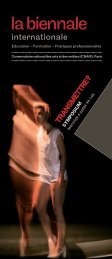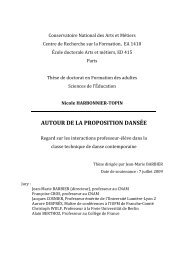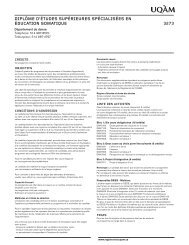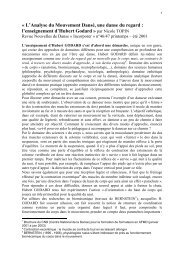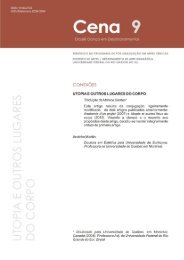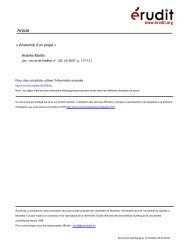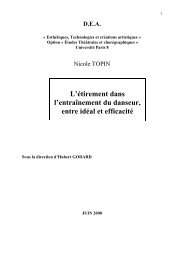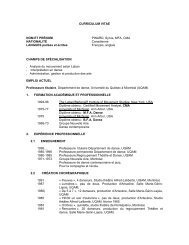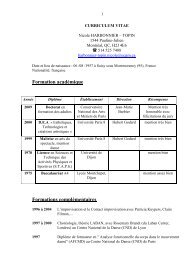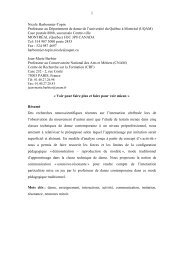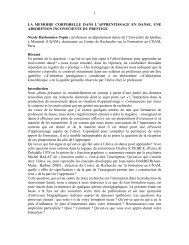Day 2 - Département de danse - UQAM
Day 2 - Département de danse - UQAM
Day 2 - Département de danse - UQAM
Create successful ePaper yourself
Turn your PDF publications into a flip-book with our unique Google optimized e-Paper software.
performatif, qui se lit à haute voix, qui s’entend. Ce lieu <strong>de</strong> travail, d’écoute et <strong>de</strong> prise <strong>de</strong> risques partagés, nécessite la<br />
présence d’un accompagnateur sensible pour que cela advienne. Ian Nielson anime le Cercle <strong>de</strong>puis sa création (?), il a la<br />
capacité <strong>de</strong> favoriser un espace d’écriture et <strong>de</strong> parole entre les différents auteurs. Dans le cadre d’un projet <strong>de</strong> recherche<br />
CRSH (2010-2013), nous avons rencontré <strong>de</strong>s auteurs du Cercle qui s’apprêtaient à présenter <strong>de</strong>s extraits <strong>de</strong> leur récente<br />
création dans au Festival découvertes / Discovery Festival, qui en était à sa <strong>de</strong>uxième année d’existence. Des entrevues<br />
semi- dirigées nous ont permis <strong>de</strong> mieux comprendre cette pratique <strong>de</strong> création individuelle qui fait appel aux autres, pratique<br />
dialogique permettant <strong>de</strong> réunir <strong>de</strong>s auteurs attentifs à leur processus <strong>de</strong> création et à celui <strong>de</strong>s autres pour que la parole<br />
advienne, celle <strong>de</strong>s personnages en action.<br />
La Troupe du Jour in Saskatoon set up Le Cercle <strong>de</strong>s écrivains ten years ago. It brings together playwrights, authors and<br />
people who have a <strong>de</strong>sire for writing. Le Cercle encourages open discussions and collaboration among participants,<br />
professional or not, who are at different stages in their writing career. All participants agree to share their creative process and<br />
their current writing with the others. Writing is normally a solitary practice but in the Cercle’s case it is as much a collective as a<br />
solitary activity, where participants read aloud and listen to others’ work; it is a place to take risks with confi<strong>de</strong>nce. The<br />
presence of a lea<strong>de</strong>r is essential in this context, and Ian Nelson has been a sensitive mentor since the beginning of Le Cercle.<br />
He has the ability to open space for writing, for discussing and generating mutually constructive feedback. As part of a SSHRC<br />
project (2010-2013), we met Le Cercle’s authors before they presented excerpts at the second Festival Découvertes /<br />
Discovery Festival (2012) in Saskatoon. Semi-directed interviews were ma<strong>de</strong> with authors, and their lea<strong>de</strong>r ma<strong>de</strong> it possible<br />
for us to grasp the characteristics of the dialogical process for writing that brought words to artistic and theatrical life in such a<br />
unique format as Le Cercle <strong>de</strong>s écrivains.<br />
c) @ the Edge of Canadian Theatre Practices: Gen<strong>de</strong>r, Age, Dis/Ability Fine Arts 103<br />
Open Panel Mo<strong>de</strong>rator: Kirsty Johnston (University of British Columbia)<br />
“In the Theatre of Excess: Sky Gilbert and the Commodification of HIV/AIDS in Canada.” Dirk<br />
Gindt (Stockholm University)<br />
The proposed paper analyzes how playwright and activist Sky Gilbert, one of the key figures and most controversial<br />
personalities in contemporary Canadian theatre, explores the continuing challenges posed by HIV/AIDS for the<br />
lesbian/gay/bisexual/transgen<strong>de</strong>r community in the twenty-first century. The paper <strong>de</strong>votes particular focus on the<br />
commodification of HIV/AIDS, not least by the pharmaceutical industry whose aggressive marketing campaigns of protease<br />
inhibitors have inva<strong>de</strong>d the gay villages of Canadian urban centers. In tan<strong>de</strong>m with these cynically commercial interests, as a<br />
community we are still faced with limited cultural representations of LGBT people with HIV/AIDS and find ourselves constantly<br />
un<strong>de</strong>r pressure to fit into and be assimilated by a neoliberal economy with its unholy trinity of individualism, <strong>de</strong>politicization,<br />
and consumption—at the expense of community activism and solidarity. Gilbert’s dramatic characters, the paper argues,<br />
attempt to resist this commodification and assimilation into neoliberal mo<strong>de</strong>s of consumption by unapologetically living out their<br />
queer sexuality. They celebrate outspokenness as opposed to complacency, shame as opposed to pri<strong>de</strong>, and excess as<br />
opposed to mo<strong>de</strong>ration. In the process, they explore complex issues such as the criminalization of HIV, consensually<br />
unprotected sex, or the controversial theories of the so-called AIDS dissi<strong>de</strong>nt movement, associated with biologist Peter<br />
Duesberg, that questions the link between HIV and AIDS.<br />
“Dissolving the Edges: Challenging Age Binaries by Viewing King Lear in Temporal Depth.”<br />
Julia Hen<strong>de</strong>rson (University of British Columbia)<br />
Constructs like ‘edginess’, ‘cutting-edge’, and ‘living on the edge’ are typically linked to youth. When yoked to old age, ‘the<br />
edge’ is most often constructed as an un<strong>de</strong>sirable barrier, a point of no-return. We speak of being ‘over the hill’, ‘slipping over<br />
the edge’ or being ‘on the brink of <strong>de</strong>ath’. Western theatrical representations of old age most often show ol<strong>de</strong>r adults as on the<br />
edge of health about to <strong>de</strong>scend into illness, on the edge of sanity about to <strong>de</strong>scend into madness, on the edge of productivity<br />
and self-sufficiency about to <strong>de</strong>scend into <strong>de</strong>pen<strong>de</strong>ncy, and on the edge of life about to experience <strong>de</strong>ath. But theatre also has<br />
great potential to re-imagine i<strong>de</strong>as about aging and old age. One way to breakdown ageist stereotypes is to challenge binary<br />
categories of age or dissolve the edges, which Anne Davis Basting and other postmo<strong>de</strong>rn theorists do by <strong>de</strong>monstrating age’s<br />
inherent performativity. However, Basting has also challenged postmo<strong>de</strong>rn discourses that, concerned not to un<strong>de</strong>rstand time<br />
as simply progressive and linear, dismiss the i<strong>de</strong>a of ageing as the embodiment of time. In the face of this criticism, Basting<br />
insists that there can still be a postmo<strong>de</strong>rn poetics of the ageing body that acknowledges its temporal component. She outlines<br />
a provocative Mo<strong>de</strong>l of the Body in Temporal Depth. As a doctoral stu<strong>de</strong>nt investigating performances of old age in<br />
contemporary theatre, I have been exploring Basting’s mo<strong>de</strong>l in relation to other productions and in this paper I offer an<br />
analysis of Shakespeare’s King Lear by Honest Fishmonger’s Coop in Vancouver, Canada.<br />
“An Analysis of Canadian Mixed-Ability Theatre Companies Working with Individuals with<br />
Intellectual Disability.” Ashley McAskill (Concordia University)<br />
Currently there are very few theatre groups in Canada that work with individuals with intellectual disability for purely artistic<br />
purposes. Theatre troupes/companies that work with individuals with intellectual disability struggle to gain recognition as a<br />
theatre group, even among inclusive arts organizations and specifically within the Disability Arts movement (a term used to<br />
<strong>de</strong>scribe the work of artists with disabilities in Canada). Needless to say, although the work of current mixed ability groups is<br />
39



